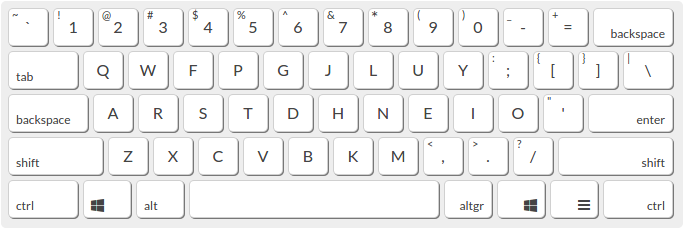Learning to Touch Type with Colemak
Although spending way too much time in front of the computer, I have always been bad at typing, being both slow and having to constantly look at the keyboard. When confronted about being slow, my response was always that it did not really matter, as most time spent programming is thinking about what to write, not the actual writing. But last year I started to waver.
After starting working, I saw how comfortable everyone was with the keyboard, and it looked nice. On top of that, I dipped my toes into competitive programming trying to go fast in Advent of Code for the first time. I went okay, and quicker typing would not have helped much. However, it is much easier to learn to touch type than to improve my competitive programming skills, so I decided to focus my efforts on the former.
How do you learn how to touch type?
There are several good websites to practice typing, such as typeracer.com and keybr.com, which are the two I used the most. I think TypeRacer is a bit more fun, and I enjoy that it uses real texts. But, in the beginning, I found Keybr useful as you can go as slow as you want without being stressed by competitors.
After using these websites for a couple of days I quickly grew frustrated and gave up. It was hard to break old habits, and I constantly found myself looking down at the keyboard. It was annoying and did not feel like a sustainable way to transition.
Instead, I decided to try out a different keyboard layout. The keyboard layout acts as an interface between the computer and the keyboard, deciding how the computer should interpret the presses of different physical keys. The most common one is QWERTY, which I used before (albeit the Swedish version), but there are quite a few more to choose from for the curious.
The main advantage of switching layout was that I would have to completely relearn how to type, which would mean I would get rid of most of my bad habits. Furthermore, I would no longer get help from looking at the keyboard, hopefully meaning I would stop doing it much easier. After some hours of Research Insights, I chose to use Colemak which is one of the most common layouts, and maintains a balance between keeping some keys while rearranging the most important ones (optimizes key layouts for more ergonomic and smooth typing).

Learning Colemak
In the beginning, progress was painfully slow, and I could not bring myself to use it at work. But after practicing a bit at home, both on training websites and hobby projects, I managed to get to the point where I could write about 10 words per minute. This is really slow, but at that point I started using it everywhere and over time became rather comfortable.
Now, I no longer have the reflex to look at the keyboard when typing (except for the number row), and I am much quicker than I ever was with QWERTY. When writing this I have an average of 63 words per minute on TypeRacer, and when trying with QWERTY before I got somewhere around 30 (I was however faster when not having to look at the screen for what to write). I'm still progressing slowly, racing a couple of games per day on TypeRacer, and I improve a wpm now and then.
Should You Switch to Colemak?
If you are like I was, not able to touch type, although wanting to, then I would recommend trying to switch layout. However, it will take quite a lot of time and effort, so if you are not motivated to switch I don't think it will be worth the pain (especially as you probably have to train at home in the beginning). But if you are willing to pay the initial price I think you, like me, could end up really appreciating the switch for (hopefully) many years to come.
Then, there are also more layouts than Colemak, such as Dvorak and Workman. I found the switch from Swedish QWERTY to Colemak to be a good level of switch for me, but if you for example already are using an American layout, you perhaps want to try another layout, which forces enough new keys on you.
If you are already comfortable writing on QWERTY I don't know if I can recommend switching. If you like the idea and enjoy keyboards/writing, it could be a nice project, but maybe not as useful as it was for me. I do think Colemak is more comfortable to write on than QWERTY, as you have to move your hands less, but in the end, the difference is probably not that big. For example, most of the fastest typists are using QWERTY.
Another reason to switch is that other keyboard layouts are optimized for finger movement, which maybe could make writing more ergonomic. From what I have heard, this is probably not the best reason. It might be a bit better, but it is probably way more important to have a good posture and a nice keyboard.
In conclusion, I am really happy that I switched to Colemak. I'm quite sure it is not for everyone, but some people like me, who will spend a large portion of their life in front of a computer, could gain a lot from trying the switch.